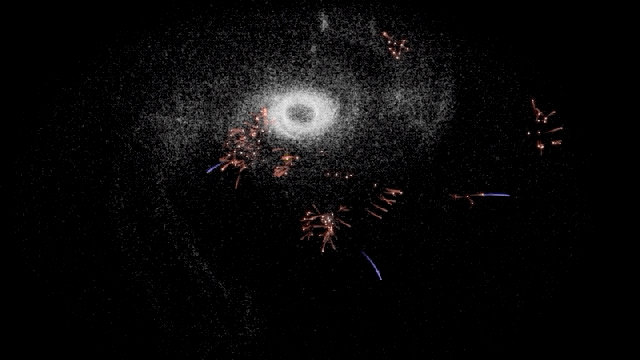A fascinating competition to devise an efficient way of colonising the galaxy has resulted in this beautiful, and provocative, visualisation.
This is the 10th running of the Global Trajectory Optimisation Competition (GTOC X), which is organised by the Mission Design and Navigation section of NASA’s Jet Propulsion Laboratory.
These contests present complex problems having to do with space travel, to which aerospace engineers, physicists, mathematicians, and computer scientists must devise efficient solutions.
GTOC X says these competitions are “a way to foster innovation in optimisation of interplanetary trajectories and cross-fertilisation of ideas between researchers in optimisation and in astrodynamics.”
For the latest competition, contestants had to settle the Milky Way galaxy in the most efficient way possible given the constraints laid out by the rules of the contest.
The winner of the competition was a joint team of China’s National University of Defence Technology and the Xi’an Satellite Control Center (their visualisation is available here), while second place went to a team from China’s Tsinghua University (video not yet available). Third place went to the Advanced Concepts Team (ACT) from the European Space Agency.
At a recent two-day workshop on interstellar exploration, ACT showcased its entry, which was uploaded to YouTube:
Each tiny white speck in the simulation represents a habitable star, while the brightly coloured lines represent the journeys taken by spacecraft between settled stars. From start to finish, the simulation encompasses tens of millions of years.
Here’s the scenario as it was presented to the contestants: About 10,000 years from now, humanity has decided to colonise the galaxy. A total of 100,000 star systems have been identified in advance as being habitable, and thus suitable for settlement.
This scenario takes place in the far future, but no radical forms of space travel exist, such as zipping through worm holes or other forms of faster-than-light travel. That said, the technology is such that long-term space travel is possible, with ships capable of supporting settlers for hundreds of thousands of generations.
“The task… is to settle as many of the [100,000] star systems as possible, in as uniform a spatial distribution as possible, while using as little propulsive velocity change as possible,” according to the GOTX contest guidelines. “The settlement of the galaxy starts by fanning out from our home star, Sol. Once another star is settled, further settlements can fan out from that star.”
Competitors were supplied with a pre-configured set of the 100,000 habitable star systems, along with the motions of these stars through space and the physics required to move the spaceships, among other criteria.
For the colonisation mission, the settlers departed Earth in three Mother Ships (shown in blue in the ACT simulation) and Two Fast ships (shown in green). Each mothership contained 10 Settlement Pods, which could be released once a Mother Ship reached a target star system.
Settlement Pods were required to perform manoeuvres to match the velocity of their target stars, while the velocity of Mother Ships were not affected by the star (gravitational slingshot effects were not allowed). A star was considered “settled” once a Settlement Pod or Fast Ship arrived there.
Once a star system was settled, and at least 2 million years had elapsed, a colony could dispatch up to three Settler Ships (shown by the reddish-pink streaks). Each Settler Ship could rendezvous with and settle a single star system. Stars could only be settled once.
It’s fair to say this scenario and the constraints provided are somewhat artificial, and not necessarily indicative of an actual future mission to colonise the galaxy. That said, exercises such as these are meaningful for astrobiologists and SETI researchers.
The general patterns seen in the simulations are probably not too far removed from how a colonisation wave might spread from a host star system, whether it be from Earth or a distant star system.
Indeed, an intriguing (or disturbing) takeaway from this simulation is the apparent ease and speed at which an entire galaxy can be subsumed, or at least explored, by an adventurous civilisation. Our galaxy is around 13.5 billion years old, or 13,500 million years old.
The GTOC X entries saw their settlers sweep across the galaxy over timescales no longer than 90 million years—a scant 0.67 per cent the age of the galaxy. Formal studies on the matter have attained results. Such is the power of exponential growth, which these simulations beautifully illustrate.
Yet, despite the Milky Way’s extreme age, we don’t appear to live in a galaxy overrun by extraterrestrial civilizations. This is an exceptionally weird observation, one dubbed the Fermi Paradox. It’s not immediately obvious why our galaxy appears to be uncolonized, and this latest simulation only adds fuel to the fire.
Duncan Forgan, a computational astrophysicist and author of Solving Fermi’s Paradox, said the new simulation is “definitely relevant” to this ongoing conundrum.
“After all, its strongest variant is that we might expect to see interstellar craft from other planets in our solar system, and the fact we don’t tells us something important,” Forgan told Gizmodo. “What that something is, is of course up for debate!”
Forgan, who wasn’t involved with the GTOC X contest, said a smart way to approach the Fermi Paradox is to ask if humans can achieve either effective interstellar communication or interstellar travel.
“Workshops like these demonstrate that there is an appetite to achieve these aims, for the purposes of scientific exploration,” he said. “If humans can do it, surely other technological civilizations could do it, too.”
